Colloquia for Fall 2017

The relative roles of radiative feedbacks and poleward heat transport in the spatial pattern of climate change
December 01, 2017
Kyle Armour
Hosted by Elizabeth Barnes
The pattern of greenhouse-gas induced climate change is not spatially uniform. For example, we have observed amplified warming in the Arctic, slow warming in the Southern Ocean and Antarctica, and an enhanced hydrologic that has increased precipitation gradients – all features that are robustly simulated by global climate models. What sets these patterns? I show that zonal-mean…
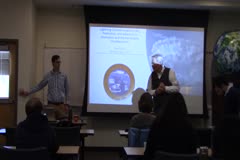
Lightning Channel Locations, LNOx Production, and Advection in Anomalous and Normal Polarity Thunderstorms
November 30, 2017
Trenton Davis
Hosted by Steven Rutledge (Advisor), Mary Barth (NCAR), Emily Fischer, Steven Reising (Electrical and Computer Engineering)
While stratospheric ozone is essential in blocking ultraviolet radiation from reaching the Earth’s surface, this process warms the environment rendering tropospheric ozone undesirable. Relatedly, tropospheric ozone production is widely studied in atmospheric science today as global climate modelers attempt to estimate future warming within the troposphere. Nitrogen oxides (NO + NO2 =…
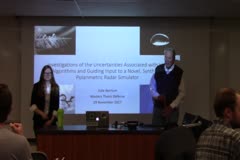
Investigations of the Uncertainties Associated with HID Algorithms and Guiding Input to a Novel, Synthetic Polarimetric Radar Simulator
November 29, 2017
Julie Barnum
Hosted by Steven Rutledge (Advisor), Michael Bell, Brenda Dolan, Steven Reising (Electrical and Computer Engineering)
With the advent of polarimetric radars, the need to produce simulated radar observables from model has also become apparent, in order to directly compare the same quantities between observations and models (e.g. rain rate calculations, hydrometeor identification - HID). To the end of evaluating model performance, for both a spectral bin microphysics (SBM) scheme and bulk microphysics scheme…
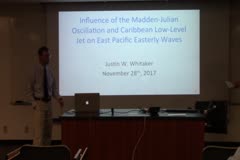
Influence of the Madden-Julian Oscillation and Caribbean Low-Level Jet on East Pacific Easterly Waves
November 28, 2017
Justin Whitaker
Hosted by Eric Maloney (Advisor), Michael Bell, Jeffrey Niemann (Civil and Environmental Engineering)
The east Pacific warm pool exhibits basic state variability associated with the Madden-Julian Oscillation (MJO) and Caribbean Low-Level Jet (CLLJ), which affects the development of easterly waves (EWs). This study compares and contrasts composite changes in the background environment, eddy kinetic energy (EKE) budgets, moisture budgets, and EW tracks during MJO and CLLJ events. While previous…
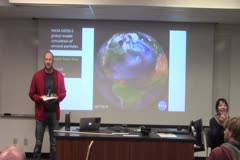
In-Situ Measurements of the Global Distribution of Aerosol Particles
November 17, 2017
Christina Williamson from NOAA ESRL, Boulder and CIRES
Hosted by Jeff Pierce
Atmospheric aerosols affect climate by direct scattering of solar radiation and by altering cloud properties. Current uncertainties in anthropogenic aerosol forcing are one of the largest factors in total uncertainties in predicting climate change. In situ measurements of the properties, origins and climatic relevance of aerosols are needed to constrain global climate models, validate satellite…
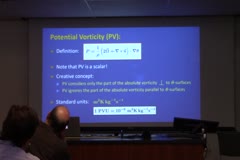
Bernhard Haurwitz Memorial Lecture (2017): Potential Vorticity Aspects of Tropical Dynamics
November 10, 2017
Professor Emeritus Wayne Schubert From Colorado State University
Hosted by Michael Bell
Bernhard Haurwitz (1905-1986) was a member of our faculty for 13 years, teaching atmospheric dynamics and doing research on atmospheric tides. He was a pioneer in the study of tropical cyclone dynamics, writing papers on this subject before satellites, weather radars, and aircraft observations. He is also known for his analysis of "Rossby-Haurwitz waves." After a review of some of…
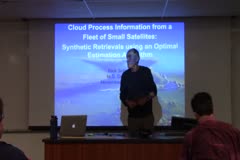
Cloud Process Information from a Fleet of Small Satellites: Synthetic Retrievals Using an Optimal Estimation Algorithm
November 10, 2017
Richard Schulte
Hosted by Christian Kummerow (advisor), Michael Bell, Steven Reising (Electrical and Computer Engineering)
The great importance of clouds in understanding atmospheric phenomena is widely recognized, yet faithful representations of cloud and precipitation processes in models at nearly all scales remain elusive. In order to properly constrain model parameters, it is important to obtain reliable observations of cloud properties in varying atmospheric environments. The Temporal Experiment for Storms and…
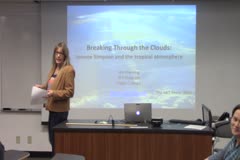
Breaking Through the Clouds: Joanne Simpson and the Tropical Atmosphere
October 20, 2017
Jim Fleming
Hosted by Jeff Collett and Sue van den Heever
Joanne Simpson was a pioneering tropical meteorologist. She earned her Ph.D. in meteorology in 1949, the first US woman to do so. However, her life encompassed much more than that gendered feat. Through a troubled childhood, three marriages, two divorces, the birth of three children, a decade-long affair, struggles with depression and migraines, and sexism in the workplace, Joanne persevered…
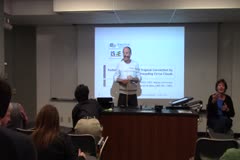
Radiative Regulation of Tropical Convection by Preceding Cirrus Clouds
October 13, 2017
Hiro Masunaga
Hosted by Chris Kummerow
Radiative-convective feedbacks are known to constitute a key element of the climate system, whereas the underlying processes have yet to be understood at a fundamental level of the convective dynamics. This work seeks evidence for convective-radiative interactions in satellite measurements, with focus on the variability over the life cycle of tropical convection. To this end, the vertical…
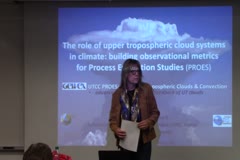
The Role of Upper Tropospheric Cloud Systems in Climate: Building Observational Metrics for Process Evaluation Studies
October 12, 2017
C. J. Stubenrauch
Hosted by Sue van den Heever
Upper tropospheric clouds, representing about 40% of the Earth's total cloud cover, play a crucial role in the climate system by modulating the Earth's energy budget and heat transport. They often form mesoscale systems. Cirrus emerge as outflow of convective and frontal systems or form in cold air supersaturated with water. Their evolution with climate change and their feedback can only be…
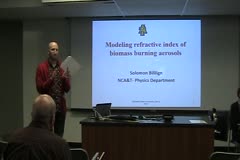
Modeling Refractive Index of Biomass Burning Aerosols
October 06, 2017
Solomon Bililign
Hosted by Jeff Pierce
The refractive index (RI) is one of the most fundamental parameters differentiating aerosol species. It is important to constrain the RI of aerosol components since there is still significant uncertainty regarding the RI of biomass burning aerosols. Experimentally measured extinction cross sections, scattering cross sections and single scattering albedos, for white pine soot under two different…
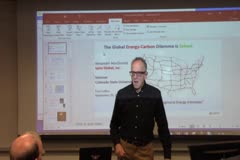
The Global Energy-Carbon Dilemma is Solved!
September 29, 2017
Alexander E. MacDonald
Hosted by Scott Denning
The United States and other developed countries have underpinned their economic advances around cheap and reliable energy during the last 130 years. In the 21st century there are two more requirements that must be met; energy must also be secure and sustainable. The dangers of climate change are now obvious to everyone except those with a vested interest in the existing system. Wind and solar…
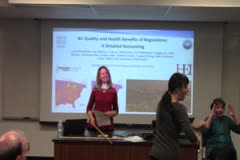
Air Pollution Accountability: Assessing Regulatory Impacts on Emissions and Air Quality
September 22, 2017
Armistead (Ted) G. Russell
Hosted by Sonia Kreidenweis
The United States has seen large improvements in air quality over the last half century with the implementation of regulations designed to reduce air pollutant emissions. Regulatory costs, estimated by the Environmental Protection Agency at tens of billions of dollars per year, motivate air pollution accountability research, which evaluates impacts of air quality regulations on emissions, air…
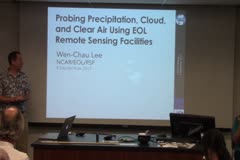
Probing Precipitation, Cloud, and Clear Air Using EOL Remote Sensing Facilities
September 08, 2017
Wen-Chau Lee
Hosted by Michael Bell
Probing precipitation, cloud, and clear air using remote sensing instruments has enabled and advanced our understanding of mesoscale phenomena and high impact weather. The Remote Sensing Facility (RSF) of the National Center for Atmospheric Research/Earth Observing Laboratory (EOL) has a long history of developing, operating and deploying radars and lidars in the past 40 years to serve the…
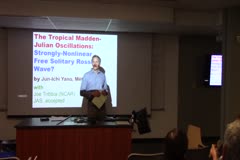
Tropical Atmospheric Madden-Julian Oscillation: Strongly Nonlinear Free Solitary Rossby Wave?
September 01, 2017
Jun-ichi Yano
Hosted by Eric Maloney
The Madden-Julian oscillation (MJO), a planetary-scale eastward propagating coherent structure with periods of 30-60 days, is a prominent manifestation of intraseasonal variability in the tropical atmosphere. It is widely presumed that small-scale moist cumulus convection is a critical part of its dynamics. However, the recent results from high-resolution modeling as well as data analysis…
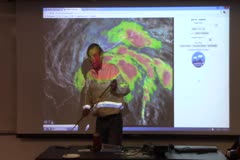
GOES-16: A New Era in Geostationary Satellite Observations
August 25, 2017
Dan Lindsey and Steve Miller
Hosted by Chris Kummerow
After dodging a close-call with Hurricane Matthew, GOES-R was launched from Kennedy Space Center in Florida on 19 November 2016. Upon reaching geostationary orbit a few weeks later, it was officially christened as GOES-16, the first in a series of next-generation satellites operated by NOAA. The primary earth-viewing environmental instruments of GOES-16 are the Advanced Baseline Imager (ABI)…
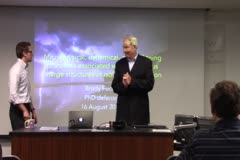
Microphysical, Dynamical, and Lightning Processes Associated with Anomalous Charge Structures in Isolated Convection
August 16, 2017
Brody Fuchs
Hosted by Steven Rutledge (advisor), Jeffrey Pierce, Brenda Dolan, Susan van den Heever, Richard Eykholt (Physics)
Internal storm charge structures are linked to storm microphysics and dynamics. This study leverages available radar-based microphysical and dynamical information from recent field campaigns to investigate the processes that influence storm-scale charge structures. Nine normal polarity (mid-level negative charge) cases that occurred in northern Alabama, and six anomalous polarity (mid-level…
